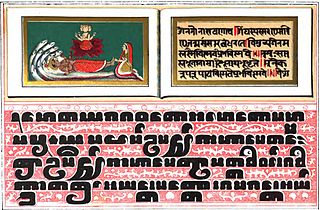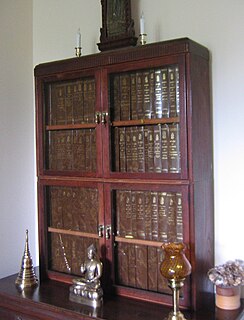| Pāli Canon |
|---|
| Vinaya Pitaka |
| Sutta Pitaka |
| Abhidhamma Pitaka |
The Abhidhamma Pitaka (Pali; English: Basket of Higher Doctrine) is the last of the three pitakas (Pali for "baskets") constituting the Pali Canon, the scriptures of Theravāda Buddhism. [1]

Pali or Magadhan is a Middle Indo-Aryan language native to the Indian subcontinent. It is widely studied because it is the language of the Pāli Canon or Tipiṭaka, and is the sacred language of some religious texts of Hinduism and all texts of Theravāda Buddhism. The earliest archaeological evidence of the existence of canonical Pali comes from Pyu city-states inscriptions found in Burma dated to the mid 5th to mid 6th century CE.

Theravāda is the most ancient branch of extant Buddhism today, and the one that preserved their version of the teachings of Gautama Buddha in the Pāli Canon. The Pāli Canon is the only complete Buddhist canon which survives in a classical Indian language, Pāli, which serves as both sacred language and lingua franca of Theravāda Buddhism. For more than a millennium, Theravāda has focused on preserving the dhamma as preserved in its texts, and it tends to be very conservative with regard to matters of doctrine and monastic discipline. Since the 19th century, meditation practice has been re-introduced, and has become popular with a lay audience, both in traditional Theravada countries and in the west.

Buddhism is the world's fourth-largest religion with over 520 million followers, or over 7% of the global population, known as Buddhists. Buddhism encompasses a variety of traditions, beliefs and spiritual practices largely based on original teachings attributed to the Buddha and resulting interpreted philosophies. Buddhism originated in ancient India as a Sramana tradition sometime between the 6th and 4th centuries BCE, spreading through much of Asia. Two major extant branches of Buddhism are generally recognized by scholars: Theravada and Mahayana.
Contents
- Origins
- Contents
- Dhammasaṅganī
- Vibhaṅga
- Dhātukathā
- Puggalapaññatti
- Kathāvatthu
- Yamaka
- Paṭṭhāna
- Place in the tradition
- Translations
- See also
- References
- External links
The Abhidhamma Pitaka is a detailed scholastic analysis and summary of the Buddha's teachings in the Suttas. Here the suttas are reworked into a schematized system of general principles that might be called 'Buddhist Psychology'. In the Abhidhamma the generally dispersed teachings and principles of the suttas are organized into a coherent science of Buddhist doctrine. [2]
The other two collections are the Sutta Pitaka and the Vinaya Pitaka. [1]




